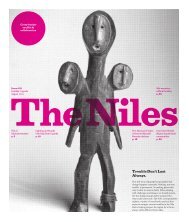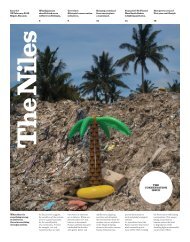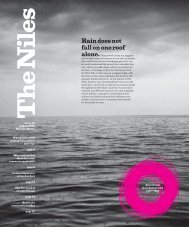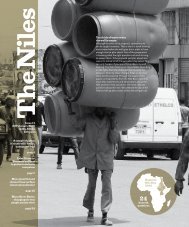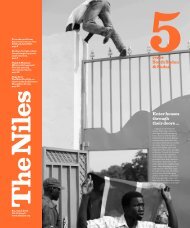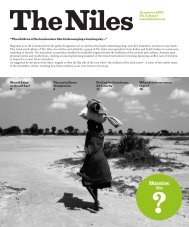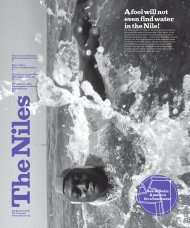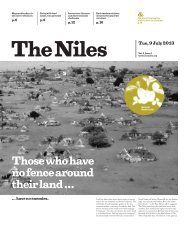A boat cannot go forward if each rows his own way
Be it to improve irrigation, manage floods and droughts or generate energy; dams have played a significant role in humanity’s progress. But the dam-building development model also has its flaws. The Niles journalists tackle the sensitive dam topic and self-aware that they all are in the same boat, they agree that it is time to start rowing the same way.
Be it to improve irrigation, manage floods and droughts or generate energy; dams have played a significant role in humanity’s progress. But the dam-building development model also has its flaws. The Niles journalists tackle the sensitive dam topic and self-aware that they all are in the same boat, they agree that it is time to start rowing the same way.
Create successful ePaper yourself
Turn your PDF publications into a flip-book with our unique Google optimized e-Paper software.
14 TN
Sudan’s dams
Alaa Eliass &
Essameldin Mohamed
Khartoum, Sudan
There are six major dams along the Nile in Sudan, all built at different times
for different purposes.
D
THE SENNAR DAM
THE JEBEL AULIA DAM
ams are ancient human constructions
that have evolved with scientific progress
and technological developments. Dams
have shifted from solely enabling water
conservation to generating electricity
and cultivating large areas of land through
flow irrigation, which has contributed
to economic and social development
in many countries.
Wherever a dam is built, a diligent
weighing of the advantages and the disadvantages
of dams, as well as the cost
for local ecosystems is required. The
overriding question is whether the
advantages outweigh the disadvantages.
Sudan is part of this global discussion,
especially when we look at the destruction
of local environments and communities
as a consequence of building some dams
in the past. Most of Sudan’s dams were
built to obtain electrical power and decrease
the danger of catastrophic floods that
hit Sudan every autumn.
But, the fact is, we still witness floods
in fall, and the electricity sector in Sudan
is still weak, with power shutdowns in
Sudan sometimes lasting for several days.
This makes us question whether they are
effective, especially given the impact on
the environment.
In an African context, Sudan is one
of the nations with the most potential
for hydropower. It is covered by 10 percent
of wetlands and has about one million
hectares of surface water. The river Nile
and its streams form its most important
source of water.
Sudan started building dams in
the 1920s utilising the country’s diverse
water resources, the most important
of which are the Blue and White Niles,
in addition to seasonal rivers such as
the Setit and the Atbara.
There are six major dams along the
Nile in Sudan (Jebel Aulia Dam, Khashm
el-Girba Dam, Merowe Dam, Roseires
Dam, Upper Atbara, Setit Dam Complex
and Sennar Dam) which were all built
at different times for different purposes
– supplying electrical power, irrigation,
protecting land and people from floods
and using dams in various projects such
as fish farms on the dams lakes.
A closer look at these dams and their
history shows a multitude of beneficial
outcomes for the people and the country:
Sennar Dam was constructed on the
Blue Nile, approximately 320 kilometres southeast
from Khartoum and 270 kilometres
downstream of the Roseires Dam.
The construction started in 1922 and
was completed in May 1925, while Sudan
was colonised by the British Empire. It
was built to irrigate the lands of the Gezira
scheme through flow irrigation and the
provision of electricity to Khartoum. This
is the oldest water dam in Sudan, and it
has a production capacity of 15 megawatts.
The dam is 3,025 metres long, with a
maximum height of 40 metres. The dam’s
80 low-level sluice gates regulate the
dam’s reservoir.
“The initial reservoir storage capacity
was 930 million cubic metres at a maximum
water surface elevation of 421.7
metres,” according to an International
Hydropower Association case study.
Today the reservoir has a storage
capacity of 390 million cubic metres
of water, and its reservoir lake extends
to more than five kilometres South of
the dam.
Sennar Reservoir contributed to
the irrigation of the Gezira and Managil
project, which boosted the productivity
of cash crops such as cotton, beans, and
wheat, transforming the Gezira region
into a meeting place for all the tribes
of Sudan.
The project contributed to raising
production and productivity rates for
Sudan and exporting cash crops, mostly
cotton, to European factories.
The Prime Minister of Egypt addressed
a letter to the British High Commissioner
in 1929, explaining that Egypt will build
the Jebel Aulia Dam to stand opposite
to the Gezira project.
The dam was inaugurated in 1938
under Egyptian administration. It was
handed over to Sudan after the Egyptian
government decided to dispense with
storage there, following the creation
of Egypt’s Aswan High Dam in 1963.
The Jebel Aulia Dam was designed
on the White Nile, 44 kilometres south
of the capital Khartoum, with a height
of 22 metres and a lake capacity of 3,5
million cubic metres. In 2003 the Sudanese
government implemented a project to
generate electricity from the dam with
30 megawatts.
The Jebel Aulia raised the water level
in the areas in front of and behind the
dam, so that the White Nile agricultural
projects in Abu Qouta, Al Fatisa, Al
Hashaba, Umm Jarr, and Al Duwaim
areas could be irrigated by pumps.
The Jebel Aulia dam and reservoir
have helped provide water for sugar and
agricultural projects, and also underpinned
the economic and social life in
the Jebel Aulia region, south of Khartoum.
The Jebel Aulia dam formed a barrier
against weeds, preventing them from
passing behind the reservoir and affecting
the main Nile.
Besides, the reservoir region is a
tourist area regularly visited by residents
of Khartoum.
TN15_20210310.indd 14 2021/03/10 18:29




